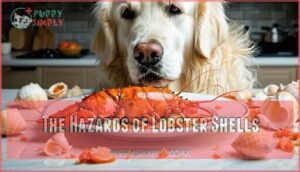This site is supported by our readers. We may earn a commission, at no cost to you, if you purchase through links.
 You can safely feed your dog lobster as an occasional treat, but preparation matters.
You can safely feed your dog lobster as an occasional treat, but preparation matters.
Dogs can enjoy plain, cooked lobster meat without shells, seasonings, or additives.
Raw lobster poses serious risks including bacterial infections and parasites, while shells can cause choking or intestinal blockages.
Start with small amounts since some dogs develop seafood allergies, causing vomiting, diarrhea, or skin reactions.
Lobster’s high cholesterol and sodium content makes it unsuitable for regular feeding.
Think of it as a special occasion snack rather than a meal replacement.
Your pup will love the taste, but there’s more to know about safe preparation methods.
Table Of Contents
- Key Takeaways
- Is Lobster Safe for Dogs?
- Nutritional Value of Lobster for Dogs
- Preparing Lobster for Dogs
- Allergic Reactions to Lobster in Dogs
- Raw Lobster and Its Dangers
- The Hazards of Lobster Shells
- Other Potential Dangers of Lobster for Dogs
- Alternative Seafood Options for Dogs
- Fruits and Vegetables for Dogs
- Nuts and Beans for Dogs
- Frequently Asked Questions (FAQs)
- Conclusion
Key Takeaways
- You can safely feed your dog cooked lobster meat as an occasional treat, but you must remove all shells completely to prevent choking hazards and intestinal blockages.
- Skip all seasonings, butter, and salt when preparing lobster for your dog – the high sodium content can cause salt toxicity and digestive issues.
- Start with tiny portions to test for seafood allergies, which can cause vomiting, diarrhea, or skin reactions in sensitive dogs.
- Never give your dog raw lobster – it contains harmful bacteria and parasites that can cause serious food poisoning and health complications.
Is Lobster Safe for Dogs?
When prepared correctly, lobster can be safe for dogs in small amounts.
This seafood offers valuable protein and nutrients, but lobster safety depends on proper preparation and portion control.
Remove all shells completely—they’re choking hazards that can cause serious internal injuries.
**Shells are choking hazards—remove them completely for your dog’s safety.
Cook thoroughly without seasonings, butter, or salt.
Start with tiny portions to check for dog lobster allergy symptoms like vomiting or skin irritation.
Breed sensitivity varies, so larger dogs handle lobster better than small breeds.
Consider cooking alternatives like plain chicken if you’re concerned about lobster risks dogs face.
Dogs can also benefit from omega-3 fatty acids found in seafood.
Always prioritize vet consultation before introducing new foods.
Nutritional Value of Lobster for Dogs
You’ll want to understand what nutrients lobster offers your dog before deciding if it’s worth the risk.
While lobster packs high-quality protein and beneficial omega-3 fatty acids, it also comes with significant drawbacks that most pet owners don’t consider.
Protein and Essential Nutrients
Lobster delivers exceptional protein benefits for your dog’s muscle maintenance and overall health.
This lean seafood provides essential amino acids that support growth and recovery.
Here’s what makes lobster nutritionally valuable:
- High-quality protein – Contains all essential amino acids dogs need
- Omega-3 power – Supports skin, coat, and joint health naturally
- Vitamin variety – B12 boosts energy and nervous system function
- Mineral sources – Zinc, phosphorus, and selenium strengthen immunity
However, note that lobster shells pose risks to your dog’s health.
Mental Health Benefits
Beyond physical nutrition, your dog’s mental well-being matters too.
Omega-3 fatty acids in lobster support brain health and may help with anxiety reduction in dogs.
These healthy fats reduce brain inflammation, potentially easing mood disorders.
Vitamin B12 enhances cognitive function and nerve health, promoting mental clarity.
The protein mental clarity connection stems from amino acids that support neurotransmitter production.
Studies suggest a seafood depression link exists, where omega-3 mood benefits contribute to overall dog wellness.
When properly prepared, lobster’s nutrients can support your pet’s emotional balance alongside physical dog health through improved pet nutrition.
However, it’s important to remember that lobster’s high sodium content requires moderation.
Potential Risks
Despite these benefits, several lobster risks dogs face deserve your attention.
Sodium toxicity from high salt content can cause excessive thirst and seizures.
Cholesterol concerns may trigger digestive issues or pancreatitis in sensitive pups.
Parasite exposure from undercooked meat poses serious health threats.
Mercury poisoning becomes possible with frequent servings.
Shell hazards create choking risks and intestinal blockages.
Dog lobster allergy symptoms include vomiting and itching.
These factors make lobster potentially toxic to dogs without proper preparation and moderation, due to serious health threats and potential chocking risks.
Preparing Lobster for Dogs
If you decide to give your dog lobster, proper preparation is absolutely essential for their safety.
You’ll need to remove all shells, avoid any seasonings, and cook the meat thoroughly to prevent serious health risks.
Removing Shells and Bones
Shell removal is your first line of defense against choking hazards and internal injuries. You must completely remove all lobster shells, including tiny shell fragments that can cause digestive issues or puncture your dog’s intestinal tract.
Safe handling means checking twice—run your fingers through the meat to catch any missed pieces. Even small bone fragments pose serious risks, as they can splinter and damage your pet’s throat or stomach lining.
Similar to lobster shells, fish bones pose risks to your dog’s health. Proper choking prevention requires cutting the meat into bite-sized pieces appropriate for your dog’s size.
Remember, shell digestion isn’t possible for dogs, making thorough removal absolutely essential for dog safety.
Avoiding Seasonings and Additives
When you’re preparing lobster for your dog, plain and simple is the way to go.
Salt dangers are real – too much sodium can lead to salt toxicosis, causing excessive thirst and potentially dangerous dehydration.
Spice toxicity becomes a concern with seasonings like garlic and onion, which are toxic to dogs and can damage their red blood cells.
Butter avoidance is smart since the high fat content can trigger pancreatitis in sensitive pups.
Sauce risks multiply when you add store-bought condiments that often contain harmful preservatives and excess sodium.
Marinade concerns include alcohol-based solutions and acidic ingredients that can upset your dog’s stomach.
Skip all the fancy prep work humans enjoy.
Is lobster safe for your dog? Yes, but only when it’s completely plain.
Can dogs have seasoned lobster? Absolutely not.
Keep it simple – your pup will appreciate the natural flavor without the health risks that come with human-style preparation methods.
Cooking Methods
When cooking lobster for dogs, stick to simple methods that preserve safety.
Boiling vs. steaming both work excellently—these techniques kill harmful bacteria while keeping the meat tender.
Simply cook the lobster in plain water without any additives.
Grilling concerns arise when you add butter or seasonings that can upset your dog’s stomach.
While grilling is acceptable, avoid extras that create problems.
Frying dangers multiply because oil and high temperatures can make the meat too rich for canines.
Safe seasonings for lobster meant for dogs? None.
Skip all spices, salt, and butter completely.
Your cooked lobster should taste plain to you but perfect for your pup.
Some owners even choose to buy pre-made lobster treats.
Portion control matters when feeding dogs lobster.
This dog treat works best in small amounts—think bite-sized pieces rather than full servings.
Is lobster safe? Yes, when properly prepared without seasonings or shells.
Allergic Reactions to Lobster in Dogs
Your dog might develop shellfish allergies just like humans do, and recognizing the signs can save their life.
Food allergies in dogs manifest differently than you’d expect, making early detection essential for your pet’s safety.
Watch for these allergy symptoms that signal trouble:
- Itchy, irritated skin around the face, ears, and paws that won’t stop
- Swelling and hives appearing within minutes of eating lobster
- Vomiting and diarrhea that starts suddenly after mealtime
- Persistent scratching leading to hair loss and skin infections
- Difficulty breathing or collapse indicating anaphylactic shock
Dog allergies to seafood can appear immediately or develop over time.
Some breeds show breed predisposition to certain allergic reactions, though any dog can develop sensitivities.
Pet allergies often start mild but worsen with repeated exposure.
If you notice any concerning symptoms, stop feeding lobster immediately and contact your vet.
Veterinary intervention becomes critical when breathing difficulties occur.
Allergy testing can help identify specific triggers, giving you peace of mind about future treats.
Raw Lobster and Its Dangers
Raw lobster poses serious health risks for your dog.
Bacterial contamination and parasite risks make uncooked seafood dangerous, potentially causing dog poisoning and severe digestive upset.
Raw lobster can harbor harmful bacteria that lead to seafood poisoning, including nausea, vomiting, and diarrhea.
Parasites present in uncooked shellfish create additional health threats.
Cooking importance can’t be overstated – proper heat treatment kills these dangerous organisms.
Safe handling means thoroughly cooking lobster before serving it to your pet, eliminating bacteria and parasites that cause illness, which is crucial for dog poisoning prevention and overall digestive upset avoidance.
The Hazards of Lobster Shells
Lobster shells pose serious risks that can turn a treat into a nightmare.
These hard, sharp fragments create multiple dangers for your pet’s health and safety.
Here are four critical hazards of lobster shells:
- Choking Hazards – Shell fragments can lodge in your dog’s throat, blocking airways and requiring emergency intervention.
- Mouth Injuries – Sharp edges slice gums and tongue tissue, causing painful wounds and potential infections.
- Intestinal Blockage – Large shell pieces can obstruct your dog’s digestive tract, creating life-threatening blockages requiring surgical removal.
- Perforation Risk – Jagged shell fragments can puncture stomach or intestinal walls, leading to internal bleeding and severe digestive issues.
Similar to crab shells, lobster shells can also cause gastrointestinal lacerations.
Always remove every trace of shell before serving lobster to prevent these dangerous complications.
Other Potential Dangers of Lobster for Dogs
Beyond shell hazards, lobster poses several hidden dangers for your dog’s health.
Heavy metals like mercury accumulate in shellfish, potentially causing mercury poisoning with regular consumption.
The high sodium content can trigger salt toxicosis, leading to excessive thirst, vomiting, and neurological symptoms.
Cholesterol risks from lobster’s fatty composition may cause digestive upset or contribute to pancreatitis danger in susceptible dogs.
These dog food risks aren’t immediately obvious but develop over time.
Pet food risks increase when lobster becomes a frequent treat rather than an occasional indulgence.
Consider these pet treat risks seriously before making lobster for dogs a regular addition to their diet.
Alternative Seafood Options for Dogs
If you’re concerned about lobster’s risks but still want to offer your dog seafood, several safer alternatives exist.
Fish like salmon, sardines, and whitefish provide similar omega-3 benefits with fewer concerns about high sodium and cholesterol levels.
Safe Seafood Choices
When choosing seafood for dogs, opt for shorter-lived fish species with lower mercury levels. Fresh salmon, sardines, and mackerel make excellent choices for your dog’s seafood diet.
Always make certain of safe preparation by cooking thoroughly without seasonings, garlic, or butter. Practice portion control – treats should comprise less than 10% of daily calories.
Watch for seafood allergies when introducing new options. For convenient options, consider browsing dog safe seafood.
Consult your vet before adding shellfish for dogs to their menu, especially if considering lobster for dogs regularly.
Benefits of Other Seafood for Dogs
While you might worry about finding safe seafood alternatives beyond lobster, many fish species offer exceptional nutritional benefits for your dog.
Salmon benefits include high levels of omega3 fatty acids that support joint health and create lustrous coats.
Sardine nutrition packs a powerful punch with protein, vitamins B12 and D, plus essential minerals.
Fish oil naturally found in these seafood options reduces inflammation and supports brain function.
When considering shrimp alternatives, cooked white fish like cod or tilapia provides lean protein without excessive cholesterol.
Safe seafood choices always require proper preparation – cook thoroughly without seasonings, remove bones, and serve in small portions.
A balanced dog seafood diet shouldn’t replace commercial dog food ingredients but can supplement nutrition when prepared correctly.
Fish varieties like mackerel and tuna offer similar omega-3 benefits.
Start with tiny amounts to check for allergic reactions.
Always consult your veterinarian before adding seafood for dogs to their regular meals, especially if your pet has existing health conditions.
Fruits and Vegetables for Dogs
While lobster can be a nutritious treat for your dog when prepared properly, you might also consider adding safe fruits and vegetables to their diet for variety and additional health benefits.
Many common produce items can provide vitamins, minerals, and fiber that support your dog’s overall wellness when given in appropriate portions.
Safe Fruits for Dogs
Fruit selection opens a world of healthy dog treats beyond traditional options. Many fruits provide excellent nutrition when prepared properly. Apples (without seeds), blueberries, bananas, and strawberries rank among the safest choices for dog health.
These fruit benefits include vitamins, antioxidants, and fiber that support your pet’s wellbeing. However, toxic fruits like grapes, raisins, and cherries must be avoided completely.
Always research preparation methods before offering new fruits. Remove seeds, stems, and pits that contain harmful compounds. Proper serving sizes matter – fruits should comprise less than 10% of your dog’s daily calories.
You can even find specialized fruit products designed for canine consumption. Watch for allergy signs including vomiting, diarrhea, or skin irritation after introducing new fruits.
Start with small portions to test tolerance. While you might consider lobster as dog treats, stick to proven safe options. Remember that dog safety comes first when selecting any treat, whether it’s fruit or considering whether your dog can eat lobster.
Safe Vegetables for Dogs
Vegetables can be excellent additions to your dog’s diet when prepared correctly.
Carrots, sweet potatoes, green beans, and broccoli offer essential vitamins and fiber that support dog health.
These nutrient-packed options make great low-calorie dog treats compared to processed alternatives.
Vegetable preparation matters substantially.
Steam or boil vegetables without seasonings, salt, or butter.
Cut them into appropriate serving sizes to prevent choking hazards.
Start with small portions when introducing new vegetables to monitor your pet’s reaction.
Toxic vegetables like onions, garlic, mushrooms, and raw potatoes must be avoided completely.
These can cause serious health issues in dogs.
Diet integration should be gradual.
Vegetables shouldn’t replace balanced dog food but can supplement nutrition.
Like lobster and other special treats, vegetables work best as occasional additions rather than dietary staples.
Some fruits, like blueberries, are safe and packed with antioxidants.
Always consult your veterinarian before making considerable changes to your dog’s diet for ideal pet health outcomes.
Nuts and Beans for Dogs
Beyond lobster, you’ll want to know about nuts and beans as dog treats.
While beans like chickpeas and lentils offer nutritional benefits including vitamins and fiber, preparation methods matter. Cook beans thoroughly to avoid bean toxicity from raw legumes.
For nuts, stick to safe portions of unsalted peanuts and cashews, avoiding toxic varieties like macadamia nuts. Watch for nut allergies causing skin irritation.
Both foods are high in sodium and can affect dogs with cholesterol concerns, so moderation is key.
Frequently Asked Questions (FAQs)
Can dogs eat seafood?
Like a ship traversing treacherous waters, you’ll need careful guidance when feeding your dog seafood.
Dogs can eat certain seafood like cooked salmon, but avoid shellfish due to high sodium and cholesterol levels that can cause digestive issues.
What happens if a dog eats lobster?
If your dog eats lobster, they’ll likely be fine if the meat was plain and cooked.
However, watch for allergic reactions like vomiting, diarrhea, or itching, especially from high sodium content.
Can dogs eat lobster shells?
Shells are like razor-sharp armor that’ll turn your pup’s digestive system into a battlefield.
Never let dogs eat lobster shells—they’re dangerous choking hazards that can cause intestinal blockages or perforate internal organs, requiring emergency veterinary intervention to prevent serious harm from intestinal blockages.
Is lobster good for dogs?
Lobster packs plenty of protein and nutrients, but it’s not a daily doggie dish.
You’ll want to serve it plain, cooked, and shell-free.
Keep portions tiny and occasional—think of it as a rare treat, not a staple.
Can dogs eat raw lobster?
Surprisingly, you’d think seafood’s always safe, but raw lobster’s actually dangerous for your dog. It contains harmful bacteria and parasites that cause serious food poisoning and digestive issues.
Can puppies eat lobster?
You shouldn’t feed lobster to puppies. Their developing digestive systems can’t handle the high sodium and cholesterol. Stick to puppy-specific food designed for their nutritional needs instead.
Is cooked lobster safe for dogs?
Yes, you can safely give your dog cooked lobster meat in small amounts. Remove all shells completely, cook it plain without seasonings, and watch for allergic reactions during first servings.
What seafood is toxic to dogs?
Like finding poisonous mushrooms in the forest, certain seafood can harm your dog.
Raw shellfish, seasoned fish, and anything with bones pose serious risks.
Stick to plain, cooked options like salmon.
Can dogs eat crab or lobster?
Dogs can eat small amounts of cooked crab and lobster meat occasionally, but you’ll need to remove all shells completely and avoid seasonings to prevent choking and digestive issues.
Why can’t dogs eat shellfish?
Actually, dogs can eat some shellfish like lobster in moderation.
The real concern isn’t shellfish being toxic—it’s the high sodium, cholesterol, potential allergens, and choking hazards from shells that make them risky treats.
Conclusion
Remember that old saying about giving a dog a bone? Well, regarding lobster, you’ll need to think differently.
Can dogs eat lobster? Yes, but only when properly prepared as an occasional treat. Remove all shells, skip the seasonings, and cook it thoroughly.
Watch for allergic reactions during your dog’s first taste. While lobster offers protein and nutrients, its high sodium and cholesterol content means moderation is key.
Your furry friend can safely enjoy this seafood delicacy with careful preparation.
















